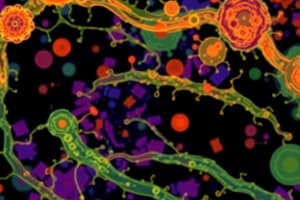Podcast
Questions and Answers
What is the appearance of Klebsiella colonies on MacConkey agar?
What is the appearance of Klebsiella colonies on MacConkey agar?
Lactose-fermenting red colonies
What is a unique characteristic of Klebsiella pneumoniae in terms of hydrogen sulphide production?
What is a unique characteristic of Klebsiella pneumoniae in terms of hydrogen sulphide production?
They do not produce hydrogen sulphide
What are the virulence factors of Enterobacter species on MacConkey agar?
What are the virulence factors of Enterobacter species on MacConkey agar?
Pink colored mucoid colonies
Which Enterobacter species is urease negative among the commonly encountered ones?
Which Enterobacter species is urease negative among the commonly encountered ones?
What is the red-colored pigment produced by Serratia marcescens?
What is the red-colored pigment produced by Serratia marcescens?
Which genus of bacteria may occasionally cause meningitis and septicemia?
Which genus of bacteria may occasionally cause meningitis and septicemia?
Name three species of Serratia that are of clinical significance.
Name three species of Serratia that are of clinical significance.
At what temperature is the pigment prodigiosin best formed in Serratia marcescens?
At what temperature is the pigment prodigiosin best formed in Serratia marcescens?
What are the typical biochemical test results for Serratia marcescens on Triple Sugar Iron (TSI) agar?
What are the typical biochemical test results for Serratia marcescens on Triple Sugar Iron (TSI) agar?
Which bacterial group includes Proteus, Morganella, and Providencia species?
Which bacterial group includes Proteus, Morganella, and Providencia species?
What is the characteristic method of movement for Proteus species on solid media?
What is the characteristic method of movement for Proteus species on solid media?
What is the virulence factor associated with Proteus species that results in rapid hydrolysis of urea?
What is the virulence factor associated with Proteus species that results in rapid hydrolysis of urea?
What are the growth characteristics of Enterobacteriaceae?
What are the growth characteristics of Enterobacteriaceae?
How can lactose-fermenting colonies be distinguished from non-lactose-fermenting colonies of Enterobacteriaceae?
How can lactose-fermenting colonies be distinguished from non-lactose-fermenting colonies of Enterobacteriaceae?
What are some common characteristics of Klebsiella, Enterobacter, and Serratia within the Enterobacteriaceae family?
What are some common characteristics of Klebsiella, Enterobacter, and Serratia within the Enterobacteriaceae family?
What are some virulence factors associated with Enteroaggregative Escherichia coli (EAEC)?
What are some virulence factors associated with Enteroaggregative Escherichia coli (EAEC)?
How are nosocomial infections related to Enterobacteriaceae?
How are nosocomial infections related to Enterobacteriaceae?
Why is the antigenic structure of Enterobacteriaceae considered complex?
Why is the antigenic structure of Enterobacteriaceae considered complex?
Study Notes
Klebsiella
- Produce extracellular polysaccharides, giving a mucoid appearance to colonies
- Do not produce hydrogen sulfide
- Fimbriated, nonmotile, and nonsporing
- Lactose-fermenting, urease-positive, and indole-negative
- Over 80 serotypes based on capsular K antigens and somatic O antigens
Enterobacter
- Motile, capsulated, and form pink, mucoid colonies on MacConkey agar
- MR negative, VP positive, indole negative, citrate positive
- 12 species, with E. aerogenes and E. cloacae most commonly encountered in clinical specimens
- E. aerogenes is urease negative, while E. cloacae is urease positive
- Associated with opportunistic infections, including UTI, respiratory tract infection, and cutaneous wounds
Serratia
- Motile, gram-negative coccobacilli that may form capsules
- S. marcescens is the most frequently encountered species
- Form smooth, convex colonies with crenated edges and produce a red-colored pigment (prodigiosin)
- TSI A/A or K/A, +/- gas, citrate +, motility +, urea +/-
- Produce DNase, lipase, and gelatinase
Proteus-Morganella-Providencia group
- Proteus species move actively by means of peritrichous flagella, resulting in "swarming" on solid media
- Urease positive, resulting in rapid hydrolysis of urea with liberation of ammonia
- Produce infections in humans, including urinary tract infections and bacteremia, pneumonia, and focal lesions in debilitated patients
- Providencia species are usually urease negative and do not swarm on solid media
- Recognized by their 'fruity' smell
Studying That Suits You
Use AI to generate personalized quizzes and flashcards to suit your learning preferences.
Description
Test your knowledge on the characteristics of Klebsiella pneumoniae, including their appearance on agar plates, motility, sporing, and biochemical properties. Explore their association with human infections and exceptions within the species.



